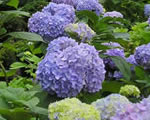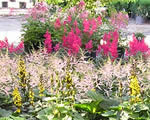You
Know You Planted It Wrong When…
By John
Ball, professor of forestry, South Dakota State University,
Brookings, SD
2003 INLA Annual Convention & Trade Show Speaker
In the
news today you can read about the possible threat of a number
of new exotic pests. Asian longhorn beetle and the emerald ash
borer, among others, have the potential to kill thousands of
trees across our nation. But whit if I were to tell you there
is a problem right now that is responsible for the loss of millions
of trees and in some communities kills one out of ten trees
planted. A new borer or blight from Asia or Europe? No- just
your average tree planter.
Planting trees seems like a simple task. Just dig the hole,
place the tree green side up, add a little water and you're
done. But we must be getting something wrong as many planted
trees never see their fifth year at their new home. And even
if they survive longer, countless more are doomed to a shortened
and stunted life. So how do you know if the tree is planted
wrong? Here is the top ten list of ways to recognize a container
tree has been planted improperly.
You
know you've planted it wrong when…
.....When you've picked the tree out from an ad. Redwoods
in Rock Rapids, Metasequoias in Mason City? It happens when
folks pick out their tree form the ads that appear every spring
promising "fast growing, low maintenance trees." Many
of these trees are only remotely hardy to the upper Midwest.
The ads often have the catch phrase "thrives in almost
any location" which should be taken as code words for don't
even think of growing it in Iowa.
.....the
first time you checked the soil was when you dug the hole. Too
often we assume if the tree can tolerate the climate, it can
tolerate the soils. But our typical urban planting site contains
a soil that is poorly drained and alkaline. If the pH is above
7.5 and water will not drain within a day from a hole then the
selection of trees to plant is going to be fairly limited. It
doesn't mean that you cannot plant a tree there - there is a
tree for almost every planting site - it just means you need
to do your homework before going to the nursery.
…..the cost of the soil amendments and supplements
cost more than the tree. Some folks believe you can
buy your way out of any planting problem. "If I just add
enough acid-forming fertilizer 'X' I'm sure I can grown eastern
pin oak on my alkaline soil" is a common hope of may tree
planters. But most amendments, be it peat, gels, vitamins, or
a host of others, cannot substitute for proper selection and
care.
…..when
you can pull branches out of the soil after you finished planting
the tree. If there is one dominate killer of newly planted
trees it is planting too deep. Many folks dig a deep hole, drop
the tree in and backfill in the mistaken belief that now the
tree can get more water. But roots (and the lower stem) also
need air. Always look for the root flare - the point on the
stem where the first major roots are attached - and this should
be placed just beneath the soil.
..…you used the depth of the container as your guide
for planting depth. Many trees at garden centers are
sitting too deep in the container. It is difficult to get a
tree to support itself in the light container soil and rather
than staking, the trees are planted deeper. In the container
this rarely results in problems as the light soil mix is well
aerated and drains properly but once home the planting depth
must be corrected.
..…you water once weather the tree needs it or not.
Sometimes the newly planted tree gets just enough water to wet
the soil and that's it. Newly planted trees, particularly container-grown
trees, need close attention paid to watering that first critical
year. The light container soils are prone to drying out and
don't easily pull in water form the surrounding soil. Folks
should make sure to water near the base of the tree, in addition
to the surrounding area, that first year to ensure the roots
are receiving water.
..…your mulch placed around the tree is mistaken for
an extinct volcano. A thin layer, 2-4 - inches of organic
mulch placed in a circle around the tree is a benefit. It can
help retain moisture, reduce competition from grass and keep
the lawnmowers and grasswhips at bay. However, a pile of mulch
against the trunk can be detrimental. It keeps the lower stem
too moist and also provides a home for rodents.
..…your staking only protects against vampires.
Young trees often need a little extra support for the first
year. The roots in the container were fairly confined and the
tree just doesn't have sufficient root spread to allow it to
resist a strong wind. But if the tree is staked too high - more
than 2/3's its height, too tight - using tightly bound wire
and rubber hose, or too long - more than one year, the staking
can become a disfigurer or killer.
..…you figure you're done when the staking is finished.
Planting is not a one-time event but a life-long commitment.
Ornamental trees are dependent on us for their care. We must
provide the training, primarily through pruning and care, mulching,
irrigation and other practices, for these trees to be healthy
and that leads into our list topper.
..…you know you planted it wrong if you outlive the
tree. While there are some tree species whose life span
can be measured in decades, most can live a century or more.
A tree that can live for 200 years certainly deserves more than
10 minutes or so to plant it. You only get one chance to plant
the tree, and mistakes made at selection or planting cannot
be corrected later in life, so take your time and do it right.



